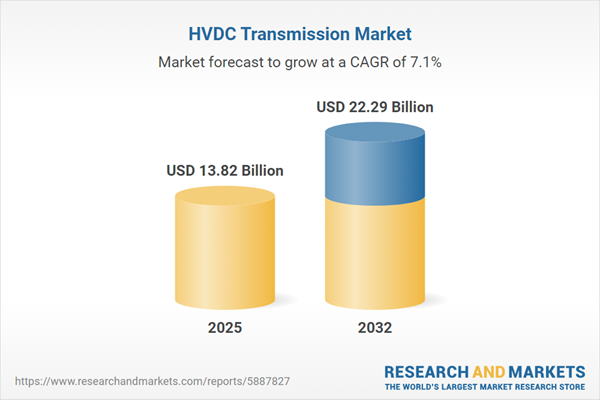Speak directly to the analyst to clarify any post sales queries you may have.
High Voltage Direct Current (HVDC) transmission is reshaping how energy is delivered by optimizing long-distance power transfer, supporting grid reliability, and advancing integration of renewable resources. As the energy sector prioritizes modernization, HVDC transmission becomes a central lever for efficient, secure infrastructure.
Market Snapshot: HVDC Transmission Market Growth and Outlook
The HVDC Transmission Market grew from USD 12.89 billion in 2024 to USD 13.82 billion in 2025, demonstrating healthy expansion. It is projected to advance at a 7.08% CAGR, reaching USD 22.29 billion by 2032. This growth reflects the urgency to upgrade existing grids, streamline cross-border energy flows, and expand renewable energy links. Investment is being fueled by the increased requirements of large-scale energy users, integration of remote generation, and ongoing grid reliability improvements worldwide.
Scope & Segmentation
This report delivers comprehensive analysis across the entire HVDC transmission value chain.
- Component: Circuit Breakers, Converter Stations, Reactors, Transformers, Transmission Cables
- Technology: Hybrid Systems, Line Commutated Converter, Voltage Source Converter, Modular Multilevel Converter, Two Level Converter
- Configuration: Bipolar, Homopolar, Monopolar
- Voltage Level: 500-800 kV, Above 800 kV, Below 500 kV
- Transmission Distance: Long Distance, Short Distance
- Application: Bulk Power Transmission, Infeed Urban Areas, Interconnecting Grids, Offshore Wind Integration, Remote Load Connection
- End User: Commercial, Industrial, Infrastructure, Utilities
- Region: Americas, Europe, Middle East & Africa, Asia-Pacific, including North America, Latin America, Europe, Middle East, Africa, China, India, Japan, Australia, South Korea, Indonesia, Thailand, Malaysia, Singapore, Taiwan
- Company Coverage: Industry players including Hitachi Energy Ltd., Siemens Energy AG, GE Grid Solutions, LLC, Mitsubishi Electric Corporation, NKT A/S, Prysmian S.p.A., Nexans S.A., LS ELECTRIC Co., Ltd., Toshiba Energy Systems & Solutions Corporation, Dongfang Electric Corporation
Key Takeaways: Strategic Insights into the HVDC Transmission Market
- HVDC technology offers significant efficiency gains over long distances, minimizing transmission losses and providing superior grid stability compared to traditional AC systems.
- The adoption of Modular Multilevel Converters and digital monitoring tools is streamlining operations, reducing maintenance, and enhancing system resilience.
- Hybrid AC-DC networks and multi-terminal HVDC architectures are enabling more flexible and scalable connection of renewables and distributed resources.
- Regional market differences are pronounced: North America is witnessing supply chain localization and technology partnerships, while Europe and the Asia-Pacific regions leverage public-private collaboration to expand cross-border and remote-area grid connections.
- Utilities and independent developers are increasingly embracing standardized modular platforms to reduce deployment risk, optimize asset performance, and shorten project timelines.
- The interplay between regulatory reforms, market integration, and investor appetite is influencing how quickly and effectively HVDC can support decarbonization and infrastructure renewal objectives in key regions.
Tariff Impact: Implications for HVDC Supply Chains
Recent tariff adjustments in the United States have driven strategic shifts in HVDC component sourcing and production. Higher import duties on critical equipment prompted an acceleration of local manufacturing, reshoring efforts, and supply agreements to mitigate exposure. The outcome has been a strengthened North American supply base, expanded technology transfer, and increased collaborative ventures between domestic and global industry leaders.
Methodology & Data Sources
This report is grounded in both primary and secondary research. Insights were gathered from interviews with sector executives, regulatory authorities, project developers, and end users. Supplementary data was obtained from proprietary databases, industry journals, and policy publications, then subjected to quantitative analysis and expert validation for accuracy.
Why This Report Matters
- Senior decision-makers will find targeted analysis supporting investment and procurement strategies for modernizing grid infrastructure with HVDC solutions.
- In-depth breakdowns of technology trends, regional market dynamics, and regulatory developments enable more informed strategic planning and risk assessment.
- The report’s actionable recommendations and scenario analysis are tailored to accelerate adoption and enhance the operational reliability of HVDC deployments.
Conclusion
HVDC transmission stands as a proven pathway toward secure, flexible, and efficient energy infrastructure. By leveraging advanced converter technologies and region-specific strategies, stakeholders can align grid investments with sustainability and reliability goals.
Additional Product Information:
- Purchase of this report includes 1 year online access with quarterly updates.
- This report can be updated on request. Please contact our Customer Experience team using the Ask a Question widget on our website.
Table of Contents
3. Executive Summary
4. Market Overview
7. Cumulative Impact of Artificial Intelligence 2025
Companies Mentioned
The companies profiled in this HVDC Transmission market report include:- Hitachi Energy Ltd.
- Siemens Energy AG
- GE Grid Solutions, LLC
- Mitsubishi Electric Corporation
- NKT A/S
- Prysmian S.p.A.
- Nexans S.A.
- LS ELECTRIC Co., Ltd.
- Toshiba Energy Systems & Solutions Corporation
- Dongfang Electric Corporation
Table Information
| Report Attribute | Details |
|---|---|
| No. of Pages | 198 |
| Published | October 2025 |
| Forecast Period | 2025 - 2032 |
| Estimated Market Value ( USD | $ 13.82 Billion |
| Forecasted Market Value ( USD | $ 22.29 Billion |
| Compound Annual Growth Rate | 7.0% |
| Regions Covered | Global |
| No. of Companies Mentioned | 11 |









